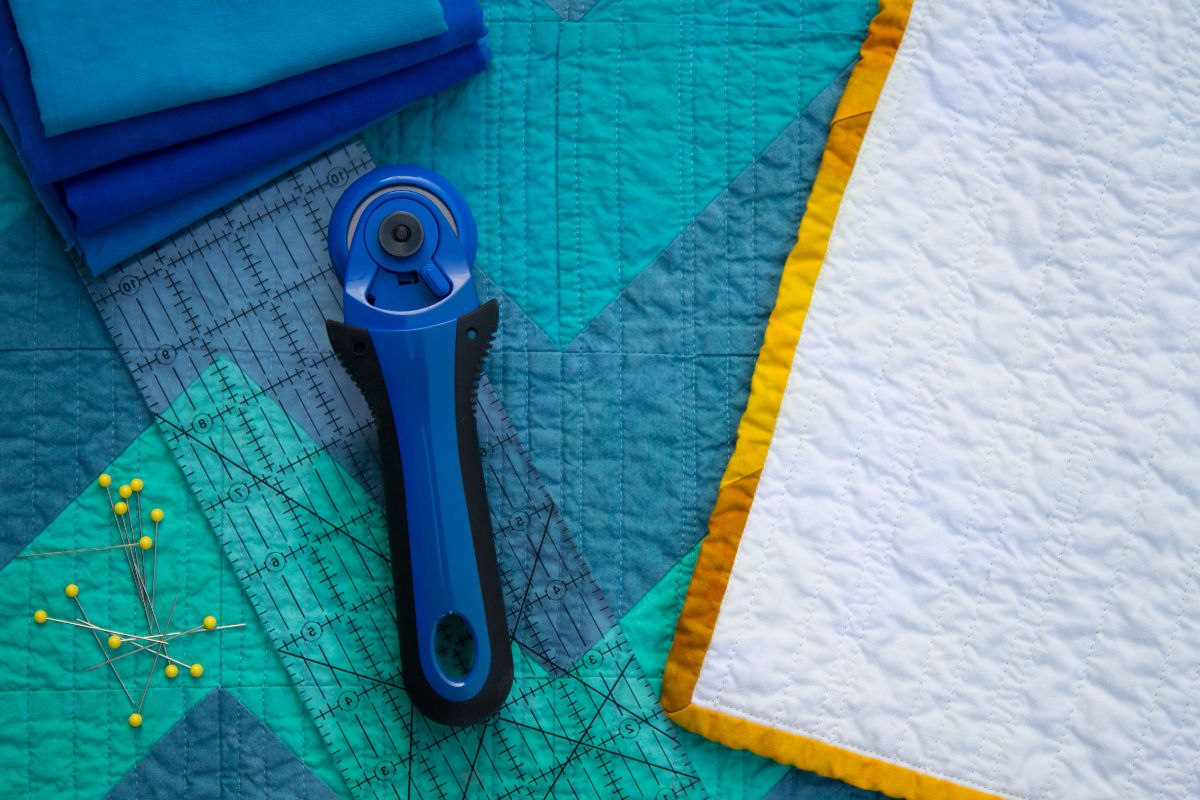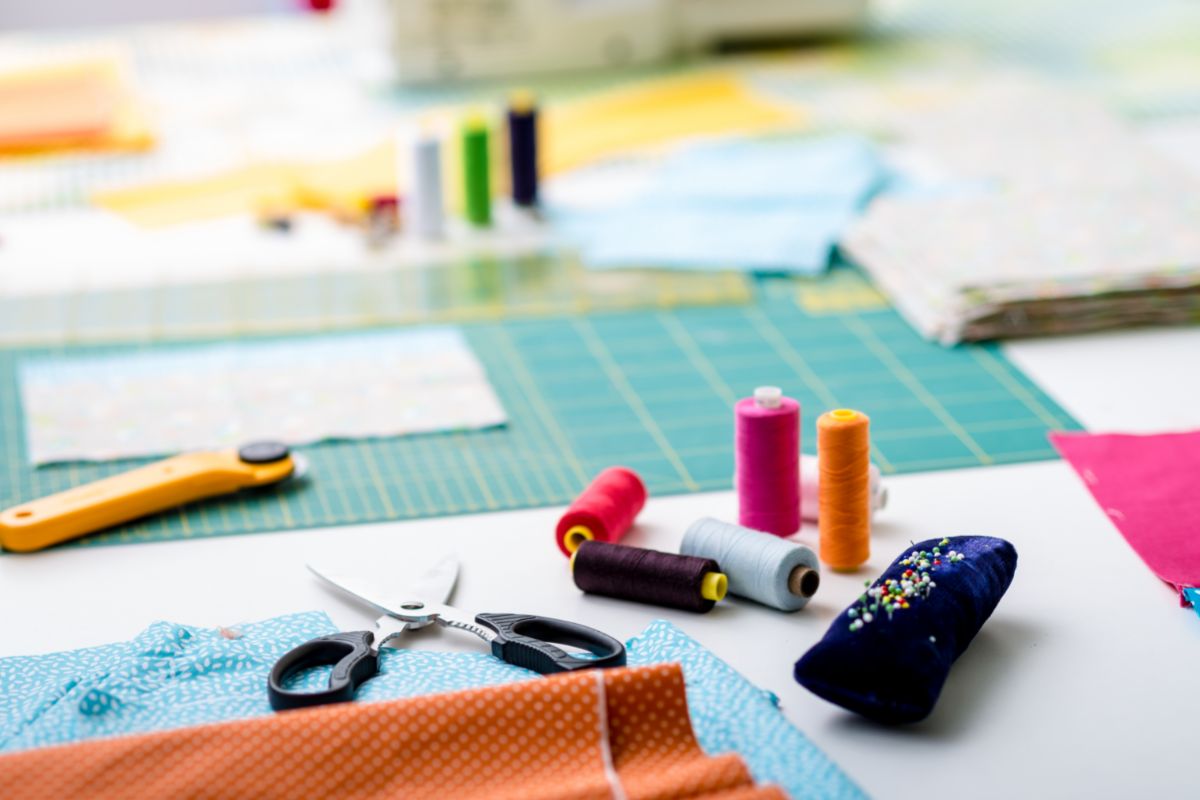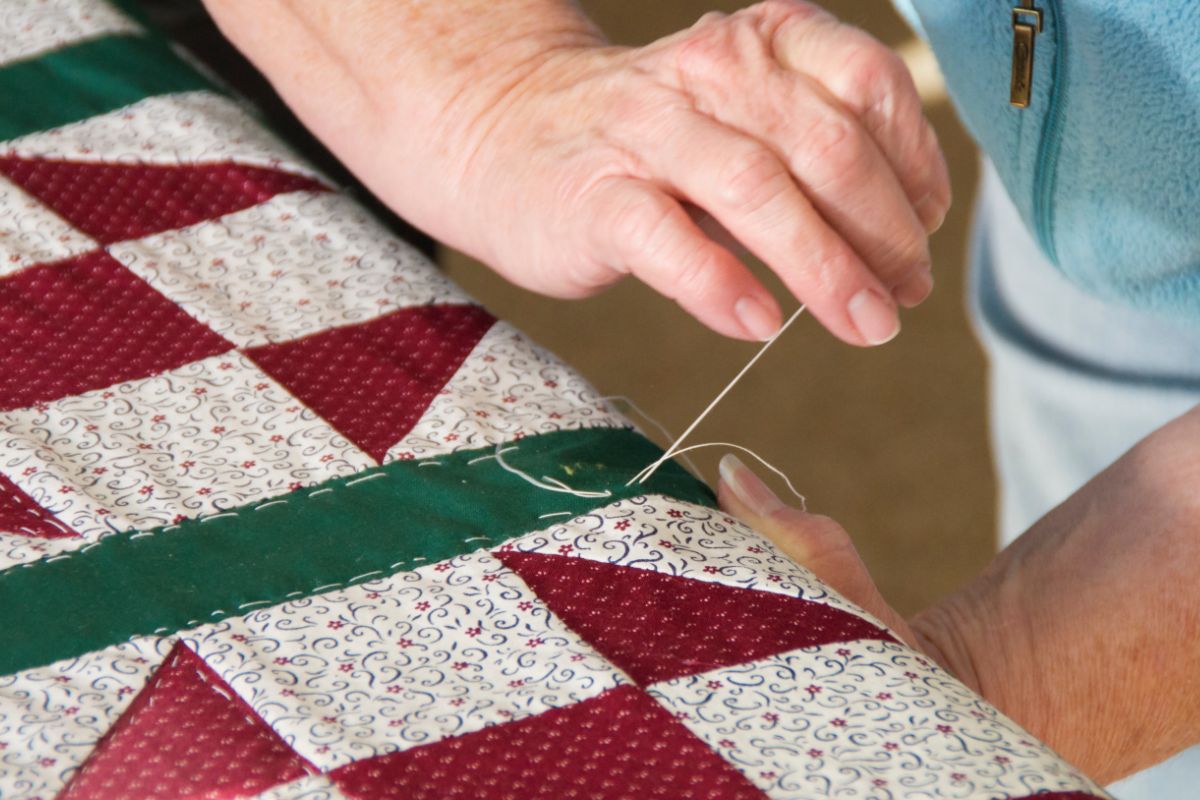When learning to sew, if you’re nervous about sewing clothes, why not try your hand at quilting… Your design can be as detailed or as simple as you like.

And it’s just a case of choosing your fabrics and following instructions as to the measurements for the quilt “sandwich” of top, batting, and backing. But if you’re unsure of how much backing you need, you’ve come to the perfect place!
Coming Up
In this article, we’ve got a handy reference chart that lays out how much backing you will need for quilts of various sizes.
We’ll also explain how to piece a quilt backing, how much bigger your quilt backing needs to be in relation to the finished quilt size, how to calculate how much backing fabric you need, and a blow-by-blow of how much backing you will need for quilts of various sizes.
Then we’ll be topping that off with a section where we explain what to do if you decide you’d rather not piece your quilt back at all. And without further ado, let’s get straight to it!
Reference Chart For Quilt Backing Sizes
Here follows a handy reference guide for you to use, spelling out exactly how much backing you need for various common sizes of quilts. Don’t forget to bookmark this page, so you can come back to it again and again as needed!
You can even add it to your Pinterest board, so that you can have it to hand whenever you need it.
| Quilt Size | Backing Size | Yardage | Piecing Reference | |
| Throw | 50” x 65” | 58” x 73” | 3 ¼ yards | Two horizontal rectangles |
| Twin | 70” x 90” | 78” x 98” | 5 ½ yards | Two vertical rectangles |
| Full | 85” x 108” | 93” x 116” | 7 ⅞ yards | 3 horizontal rectangles |
| Queen | 90” x 108” | 98” x 116” | 8 ¼ yards | 3 horizontal rectangles |
| King | 110” x 108” | 118” x 16” | 9 ¾ yards | 3 horizontal rectangles |
So, now you know the “how much”, now it’s time for the “how to”.
A Step-By-Step Tutorial On Piecing Quilt Backing
So, if you’re making a quilt in any of the sizes laid out in the table above, you now have the precise measurements you will need. If however you happen to be making a quilt of another size, do not worry, we’ll be coming to that shortly.
But before we get into that, let me walk you through piecing your quilt backing together in this easy-to-follow step-by step tutorial.
- Step One: Begin by removing the selvages from your fabric.
- Step Two: Cut the long length of your fabric to size (whether in half or in thirds).
- Step Three: Place your fabric pieces in position with the correct sides facing one another.
Handy Hint: I recommend pinning these two pieces of fabric together before you begin sewing, since this helps to not only hold the fabrics together, but also ensure they remain aligned as you intended.
- Step Four: Begin carefully sewing the two pieces together, with a ½ inch seam allowance. This seam allowance on the back of the quilt serves to increase the stability of the quilt.
- Step Five: Reduce bulk by pressing your seam open.
- Step Six: Trim down any excess fabric around the edges of the quilt back to bring it to your desired size. This removes unnecessary bulk, which in turn makes it easier to quilt. Ensure that you trim evenly from each side, such that the seam in the back remains centered.
How Much Bigger The Quilt Backing Needs To Be Relative To The Quilt Top?
The general rule for your quilt backing is that it should be a minimum of 4 inches larger than the quilt top. In other words, this means that you have to add 8 inches to both the length and the width of the finished quilt to know what size of backing you need.
Here’s a quick example for you. If your finished quilt size is 70 inches by 90 inches (twin size), then you will need a quilt backing measuring 78 by 98 inches.
Calculating How Much Fabric You Need For Backing
In order to work out how much fabric you’re going to need to back your quilt, you have to begin with understanding the size of a yard of fabric. You likely already know that a yard of fabric is 36 inches long. But you also need to know the width as well.
Truth be told, the width of quilting fabric can vary. However, the most common width comes in at 42 inches, so this is the value that we’ll be using for the remainder of this article.
We’ll walk you through how to calculate the amount of fabric you need to back your quilt by way of an example. Let’s say that you want to make a quilt that measures 60 inches by 70 inches.
You will need your backing fabric to measure an extra 4 inches larger than this on every single side. This means that you will need to add 8 inches to the length, and 8 inches to the width.
So, for a quilt measuring 60 by 70 inches, this means that your backing fabric needs to be 68 by 78 inches. But before we get into any more detail, you will have to assess whether you’re going to use a horizontal or a vertical seam on the quilt backing.
Personally, I prefer using a horizontal seam, since that way you usually use less yardage. I also find it easier to do. But whatever you prefer is fine, and I’ll explain how to work out the backing yardage for a vertical seam, and for a horizontal seam.
Calculating The Backing Yardage For A Vertical Seam
So, for this example, if you’re going for a vertical seam, you need to piece two widths of backing fabric side by side. If you put two standard widths of fabric together, this comes to 42”+42” (minus a seam allowance of 1”) =82”.
This is more than enough to cover the 68 inches to back your quilt. Now for the length of fabric. Given that two yards of fabric is 72 inches (36+36), you can see that is not enough to cover the necessary 78 inches that you’ll need.
So, if you were to add another quarter yard of fabric, you will end up with a length of 81 inches (since 36”+36”+9”=81”), more than enough to cover the 78 inches.
And since there will be two pieces of fabric lying side by side, you’ll have to double the 81-inch length of fabric, i.e. 2 ¼ yards, which means that you will need a 4 ½ yards length of backing fabric.
Calculating The Backing Yardage For A Horizontal Seam

In this example of a 60 by 70 inch finished quilt, if you wanted to create a horizontal seam, again you would also have to piece two widths of fabric together. But this time, you lay one piece above the other. It’s just like with the vertical seam, except that the fabric has been turned 90 degrees.
Piercing two standard widths of fabric together this way gives you 83 inches, (since 42” + 42” [-1” seam allowance] = 83”). This is more than enough to make up the desired quilt backing length of 78 inches.
Next we come to the width of the quilt backing. Two yards of fabric comes to 72 inches (36”+36”), and this is more than sufficient to cover the necessary 68 inches width that you need.
But since you’ll be laying two pieces together, you need to double this yardage, which means that you will need 4 yards of backing fabric in total in order to create a horizontal seam.
At this point, you may have picked up on the fact that doing a horizontal seam for your quilt backing means that you will be using a significantly shorter yardage of backing fabric, half a yard less.
This is why I recommend that you carry out the math work beforehand, so that you can make the most of your backing fabric. Now let’s get into how much backing you need for specific standard sizes of quilt.
How Much Backing You Will Need For A Baby Quilt?
The standard baby quilt measures 30 inches by 40 inches. And when you apply the rule of adding 4 inches to every side, both lengths and widths, for the backing, this will come to 38 inches by 48 inches. For a standard 30 by 40 inch baby quilt, you will need 1 ⅜ yards of backing fabric.
The great thing about standard size baby quilts is that you won’t need to piece fabric together for backing, since the width of a yard of fabric comes in at 42 inches, which is larger than the width you need of 38 inches.
This means that you will need a length of fabric measuring a yard and 3/8ths, or in other words 49.5 inches, for the backing. However, if the width of your finished quilt is intended to be wider than 34 inches, then you’ll have to piece the backing fabric together.
How Much Backing You Will Need For A Throw Size Quilt?
A standard throw size quilt measures 50 inches by 65 inches. And when you apply the rule of adding 4 inches to every side, both lengths and widths for the backing, this will come to 58 inches by 73 inches.
For a standard 50 by 65 inch throw size quilt, you will need 3 ¼ yards of backing fabric. Since this is a wider width than fabric is usually sold in, this means that you will need to piece your backing fabric together.
The most efficient way to use your backing fabric is to use a horizontal seam. What you need to do is cut your 3 ½ yard length of fabric evenly into two halves, so that you’re left with two 1 ⅝ yard length pieces.
Sew these two pieces together lengthwise, to achieve a pieced backing measuring 58.5 inches by 83 inches.
This will provide you with a slightly larger piece of backing than you actually need, so you must trim the edges down evenly, on all the sides, so that the backing measures 58 inches by 73 inches.
How Much Backing You Will Need For A Twin Size Quilt?
A standard twin size quilt measures 70 inches by 90 inches. And when you apply the rule of adding 4 inches to every side, both lengths and widths, for the backing, this will come to 78 inches by 98 inches.
For a standard 70 by 90 inch twin size quilt, you will need 5 1/2 yards of backing fabric. The most efficient way to use your backing fabric is to use a vertical seam.
What you need to do is cut your 5 ½ yard length of fabric evenly into two halves, so that you’re left with two 2 ¾ yard length pieces. Next, you will need to sew these two pieces together lengthwise in order to produce a pieced together backing measuring 83 inches by 99 inches.
You will notice that this is actually a larger piece than you need, so you will have to trim the backing fabric down as evenly as possible, on all the sides, so that you are left with backing fabric measuring 78 inches by 98 inches.
Handy Hint: It can be tricky to cover your quilt back when you are making a twin size quilt using standard fabric widths of just 42 inches, since you could easily end up wasting a great deal of fabric.
For this reason, we recommend that you use a vertical seam. We wouldn’t want you to waste good fabric.
How Much Backing You Will Need For A Full Size Quilt?

A standard full size quilt measures 85 inches by 108 inches. And when you apply the rule of adding 4 inches to every side, both lengths and widths, for the backing, this will come to 93 inches by 116 inches.
For a standard 85 by 108 inch full size quilt, you will need 7 ⅞ yards of backing fabric. The most efficient way to use your backing fabric is to use two horizontal seams.
What you need to do is cut your 7 ⅞ yard of fabric into two thirds, to produce three pieces measuring 2 ⅝ yards. Next, you will need to sew these three pieces together lengthwise in order to produce a pieced together backing measuring 94.5 inches by 124 inches.
Of course, this is a larger piece of backing fabric that you need, so you will have to trim the fabric down evenly on all the sides in order to get it to measure 93 inches by 116 inches.
How Much Backing You Will Need For A Queen Size Quilt?
The standard baby quilt measures 90 inches by 108 inches. And when you apply the rule of adding 4 inches to every side, both lengths and widths, for the backing, this will come to 98 inches by 116 inches.
For a standard 90 by 40 inch queen size quilt, you will need 8 ¼ yards of backing fabric. The most efficient way to use your backing fabric is to use three horizontal seams.
What you need to do is cut your 8 ¼ yards of backing fabric into thirds, so that you have three pieces of fabric measuring 2 ¾ yards in length.
Next, you will need to sew these three pieces together lengthwise in order to produce a pieced together backing measuring 99 inches by 124 inches.
Of course, this is a larger piece of backing fabric that you need, so you will have to trim the fabric down evenly on all the sides in order to get it to measure 98 inches by 116 inches.
How Much Backing You Will Need For A King Size Quilt?
The standard king-size quilt measures 110 inches by 108 inches. And when you apply the rule of adding 4 inches to every side, both lengths and widths for the backing, this will come to 118 inches by 116 inches.
For a standard 110 by 108 inch king-size quilt, you will need 9 ¾ yards of backing fabric. What you need to do is cut your 9 ¾ yards of backing fabric into thirds, so that you have three pieces of fabric measuring 3 ¼ yards in length.
Next, you will need to sew these three pieces together lengthwise in order to produce a pieced together backing measuring 117 inches by 124 inches.
Of course, this is a larger piece of backing fabric that you need, so you will have to trim the fabric down evenly on all the sides in order to get it to measure 118 inches by 116 inches.
Non-Pieced Quilt Back Options
If you don’t fancy piecing together your quilt backing, I totally get – you just pieced the whole quilt top together after all! So, you may be pleased to hear that there are other options…
Extra Wide Backing Fabric
For instance, it turns out that there’s fabric you can buy that’s specially made for quilt backing. It’s extra wide, coming in at a staggering 108 inches wide. If you can get your hands on such backing fabric, then all you’d have to do is sew this one large piece of fabric to the back of the quilt.
Alternative Fabric
But that’s not your only alternative option, you could use a flannel sheet or cotton sheet to provide the back of your quilt. If you decide to use a cotton sheet, be sure that it’s made with 100% and that you get it to the perfect size for your quilt.
If, however, you decide to use a flannel sheet, I strongly suggest that before quilting you give it a pre-wash (even if you don’t manage to pre-wash the rest of your quilt fabric). This is because flannel has a tendency to shrink in the wash more than cotton does.
Wrap Up
So, to summarize, the general rule of thumb for quilt backing is that it should be at least 4 inches longer and wider than the quilt top.
But since fabric is typically sold by the yard in widths of 42 inches, and most quilts are larger than that, this means that you’ll have to piece your quilt back together by cutting your backing fabric into pieces, sewing them together lengthwise, and trimming them down to the perfect size.
All the measurements you need are provided in the reference chart at the beginning of the article, with more detailed instruction following later. Piecing the backing fabric together using horizontal seams is usually the best way to ensure that there’s minimal fabric wastage.
But if you scroll back, you will find that you’ve got the instructions for working out what yardage of backing fabric you need, whether you go for a horizontal or vertical seams. I recommend that you do your calculations before deciding whether to use a horizontal or vertical seam.
You may even be able to get away with not piecing a backing for your quilt at all if you were to use a cotton sheet or a flannel sheet instead. Whatever you decide, all the info you need is right here. Happy crafting!
- Master Crochet Stitches for Cozy Creations - January 23, 2024
- Half Double Crochet Guide for Cozy Creations - January 23, 2024
- Elevate Your Space with Unique Macrame Creations - January 23, 2024

